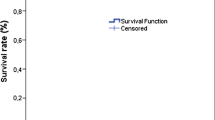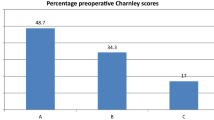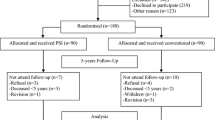Abstract
Purpose
The aim of this study was to analyse the long-term (>ten years) survival rate and radiological results of the Duracon TKA.
Methods
Between 1992 and 1999 159 Duracon TKA were implanted at our institution. A Kaplan-Meier survival analysis for the endpoints exchange, addition or removal of any component for any reason, revision due to aseptic loosening and mechanical failure was performed. Radiological long-term (>ten years) follow-up (FU) analysis was performed according to the Knee Society Radiographic Evaluation and Scoring System.
Results
Mean age at surgery was 74.3 years, 28 % were male, and 89 % had primary osteoarthritis as diagnosis. Mean FU for survival analysis was 10.9 years (SD 4.2). A total of 58 % of the patients died during follow-up. Three patients (2.1 %) were lost to follow-up and five TKA (3.1 %) were revised. After ten years the mean survival was 97.7 %, 99.4 % and 98.3 % for the aforementioned endpoints, respectively. Mean radiological FU was 11.8 years (SD 2.3). We found no significant change in alignment of the components or axis over time. Progressive radiolucencies were found in nine TKA (17 %), mainly around the tibial component (95 %).
Conclusion
The Duracon TKA showed excellent long-term survival comparable to data from national registers and to other successful designs. Radiological changes found on plain radiographs were scarce after almost 12 years of radiological follow-up indicating good implant stability.
Similar content being viewed by others
Avoid common mistakes on your manuscript.
Introduction
Total knee arthroplasty (TKA) is the standard treatment for end stage degenerative and rheumatologic knee diseases [3, 18]. The main reasons for revision are mechanical failure (instability, polyethylene wear, malposition, impingement, over-/undersizing), aseptic loosening and infection [9]. Most early revisions are for mechanical reasons or infection, whereas late failure is mostly due to aseptic loosening [2, 9].
The Duracon TKA (Stryker) is a posterior cruciate ligament retaining system and has a congruent articular surface aiming to maintain a substantial contact area throughout the whole range of motion and limit contact stress even in conditions of varus/valgus malalignment [12, 21]. The tibial component is cemented, while the femoral component can be implanted either cementless (hybrid) or cemented. No design changes have been made since it was introduced to market.
Only few studies on early (two to five years [12, 21, 29]) and mid-term (five to ten years [10, 13, 15]) survival results for the Duracon TKA have been published with survival rates between 97 and 99 % and 96–98.6 %, respectively. Long-term survival data is available mainly from the Scandinavian Knee Arthroplasty Registers [11, 24, 26].
The aim of this study was to analyse long-term (>ten years) survival and radiological results of the Duracon TKA (Stryker Howmedica, Rutherford, NJ, USA) for 159 consecutive cases.
Patients and methods
Between December 1992 and May 1999, 159 primary Duracon TKA were implanted in 137 patients at our institution (Table 1). During that period it was the most commonly used implant (85 %) at our institution.
Eleven surgeons performed the operations; 14 knees (9 %) had been operated with a closing wedge tibial valgus osteotomy (TVO) prior to TKA. A total of 153 cases (96 %) had a medial parapatellar approach, with three of them combined with an osteotomy of the tibial tubercle. Six (4 %) cases had a lateral parapatellar approach after previous TVO, whereby two were combined with an osteotomy of the tibial tubercle. All 159 tibial and 35 femoral components (22 %) were cemented using Palacos G bone cement (Haereus Medical, Weinheim, Germany) without antibiotics. The patella was resurfaced in 12 cases (8 %).
Postoperatively, continuous passive motion exercise was started and full weight bearing ambulation was permitted under guidance of physical therapy as soon as possible. Clinical and radiological follow-up were scheduled prospectively at four months, one year, five years and every five years postoperatively according to our in-house register [5].
Dates of death were crosschecked with the regional authorities. Survival analysis was performed using Kaplan-Meier analysis with endpoints (1) exchange, addition or removal of any component for any reason, (2) revision due to aseptic loosening and (3) revision due to instability and/or polyethylene wear.
Clinical data were retrospectively obtained from medical records and contained ROM (measured with a goniometer) and whether patients were scheduled for surgery due to problems with the TKA.
Standardized weight bearing short anterior–posterior (AP) and true lateral radiographs were taken. Radiological evaluation was done according to the Knee Society radiographic evaluation and scoring system [8] (Fig. 1). Changes in alignment of the components were analysed comparing the angles of the first and last available radiographs. All radiographs were examined for progressive radiolucencies as defined by Ewald [8] by two reviewers (MB and MC) and were defined as a consensus if both found radiolucencies.
Statistics
Data are presented as mean, standard deviation (SD) and range. Statistical analysis was done using SPSS version 20 (IBM, Armonk (NY), USA). A p-value < 0.05 was defined as significant. Data was analysed for normal distribution using Kolmogorov-Smirnov analysis. As data for the angles α, β, γ, δ and varus-valgus were normally distributed, differences between groups were calculated using the Student’s t-test for paired samples. Data for radiolucencies were not normally distributed thus the non-parametric t-test for independent samples was used.
Results
Follow-up
During follow up, three of 159 (2 %) TKA were lost to follow-up. For 92 (58 %) TKA the patient had died unrelated to the TKA. Five TKA (3 %) were revised: one for aseptic loosening of the tibial component at 2.5 years and four for mechanical failure (two because of instability at eight and 14 years; two because of excessive polyethylene wear at nine and 15 years). Sixteen cases (10 %) had postoperative complications that required surgical procedure without exchange, addition or removal of any component (Table 2).
Survival analysis
Survival with the endpoint exchange, addition or removal of any component for any reason was 97.7 % (95 % CI, 95.1–100 %) after ten years and 94.8 % (95 % CI, 88.7–100 %) after 15 years. Survival for revision due to aseptic loosening was 99.4 % (95 % CI, 98.1–100 %) after ten and 15 years. Survival for revision due to mechanical causes (excessive wear, instability) was 98.3 % (95 % CI, 96.1–100 %) after ten years and 95.5 % (95 % CI, 89.4–100 %) after 15 years (Fig. 2).
Clinical and radiological results after more than ten years follow-up
Sixty-one TKA had a clinical and radiological follow-up of more than ten years. The mean TKA follow-up was 12 years (SD 2, range 10–19). The mean ROM was flexion/extension 113/0/0 (SD 13/0/5) and none of the patients was scheduled for revision surgery. There was no difference in ROM for TKA with a prior tibial valgus osteotomy (flexion p = 0.7, extension p = 0.5).
There was no difference in alignment between TKA with a follow-up of greater than or less than ten years. Seven of 61 TKA with a follow-up greater than ten years had incomplete radiographs and were excluded from radiological analysis. On the latest postoperative radiograph the mean femoral flexion (α) was 98° (SD 3°, range 91–106°), the mean tibial angle (β) was 88° (SD 3°, range 78–95°), the mean femoral flexion (γ) was 2° (SD 2°, range -6 to 4°) and the mean tibial slope (δ) was 85° (SD 3°, range 75–93°). The femorotibial angle was 6° varus (SD 4°, range 4° valgus to 7° varus). Mean differences between first and last postoperative femoral and tibial radiological angles were: ∆α = 0.4° (p = 0.14), ∆β = 0.2° (p = 0.45), ∆γ = -1° (p = 0.06), ∆δ = 0.1° (p = 0.8) and ∆femorotibial angle = 0.5° (p = 0.4). Overall alignment of the knee (femorotibial angle) was neutral (±4°) in 45 (83 %) TKA, varus in four (8 %) TKA and valgus in five (9 %) TKA. Overall alignment was independent from diagnosis (p = 0.08), gender (p = 0.42) and previous tibial valgus osteotomy (p = 0.41).
Progressive radiolucencies were found in nine TKA (17 %) mainly on the tibial side (95 %, Table 3, Fig. 3) and were detected after a mean time of seven (SD 2) years. Femoral radiolucencies were uncommon, and we found no difference between cemented and uncemented femoral components (p = 0.661). Five (8 %) of 61 TKA had an initial patella resurfacing, none of them showing radiological changes over time.
Discussion
Our long-term survival study confirms the excellent short- and mid-term survival data for the Duracon TKA. Furthermore, this study is the first to present radiological long-term data for this specific design.
The average age in our series was rather high (74 years), thus scoring systems analysing global function might have been inferior in this group. In any case, the observed results concerning ROM and especially the low flexion rate are comparable with the literature [28] and confirm the results of the short-term studies [12]. Additionally, the results are acceptable for the setting of a teaching hospital with 11 surgeons being involved in 159 TKA. Functional results might be better in a specialized high volume setting. None of the patients was scheduled for revision surgery at final follow-up.
Plain radiographs are the most commonly used modality determining alignment of the components, although gold standard is 3D-CT [14, 25]. We used the “Knee Society total knee arthroplasty radiological evaluation and scoring system” [8] which is an accepted tool for radiological analysis [1, 25]. Restoration of alignment is thought to play an important role in improving survival of TKA [23] and functional outcome [4, 19]; thus we focused our radiological analysis on TKA with a minimum follow-up of more than ten years. The radiological angles we measured did not differ from the angles other studies measured [27] and showed no (clinically relevant) changes during follow-up. As in other studies, alignment was not influenced by prior tibial valgus osteotomy [20]. Progressive radiolucencies were scarce and found in nine TKA (17 %) mainly located on the tibial side, which is comparable to other studies [8, 17, 22]. Femoral radiolucencies were rare and independent from fixation of the component (cemented vs. uncemented). Difficulties observing radiolucent lines around femoral components is a well-known problem but independent from the type of fixation [7, 27]; thus, from our data we cannot recommend the use of cemented or uncemented components.
A limitation of the study is that the clinical evaluation was done retrospectively, using medical records only, but no clinical scoring system like, for example, the Knee Society clinical rating system [16] or Oxford Knee score [6].
Conclusion
The Duracon TKA showed excellent long-term survival comparable to data from national registers and to other successful designs. The ROM with an average flexion of 113° was comparable to the literature and acceptable for most daily living activities, but inferior to modern high-flexion designs. Radiological changes found on plain radiographs were scarce after almost 12 years of radiological follow-up indicating good implant stability.
References
Bach CM, Steingruber IE et al (2001) Radiographic assessment in total knee arthroplasty. Clin Orthop Relat Res 385:144–150
Callaghan JJ, O’Rourke MR et al (2004) Why knees fail: lessons learned. J Arthroplasty 19(4 Suppl 1):31–34
Carr AJ, Robertsson O et al (2012) Knee replacement. Lancet 379(9823):1331–1340
Choong PF, Dowsey MM et al (2009) Does accurate anatomical alignment result in better function and quality of life? Comparing conventional and computer-assisted total knee arthroplasty. J Arthroplasty 24(4):560–569
Clauss M, Gersbach S, Butscher A, Ilchmann T (2013) Risk factors for aseptic loosening of Muller-type straight stems: a registry-based analysis of 828 consecutive cases with a minimum follow-up of 16 years. Acta Orthop 84(4):353–359
Dawson J, Fitzpatrick R et al (1998) Questionnaire on the perceptions of patients about total knee replacement. J Bone Joint Surg Br 80(1):63–69
Ecker ML, Lotke PA et al (1987) Long-term results after total condylar knee arthroplasty. Significance of radiolucent lines. Clin Orthop Relat Res 216:151–158
Ewald FC (1989) The knee society total knee arthroplasty roentgenographic evaluation and scoring system. Clin Orthop Relat Res 248:9–12
Fitzgerald SJ, Trousdale RT (2011) Why knees fail in 2011: patient, surgeon, or device? Orthopedics 34(9):e513–e515
Furnes O, Espehaug B et al (2002) Early failures among 7,174 primary total knee replacements: a follow-up study from the Norwegian Arthroplasty Register 1994-2000. Acta Orthop Scand 73(2):117–129
Gothesen O, Espehaug B et al (2013) Survival rates and causes of revision in cemented primary total knee replacement: a report from the Norwegian Arthroplasty Register 1994-2009. Bone Joint J 95-B(5):636–642
Greene KA, Magoline MR et al (1998) Primary total knee arthroplasty using the Duracon total knee system, 2- to 5-year follow-up study of 100 knees. http://aboutjoints.com/physicianinfo/topics/duracontkasys/duracontka.htm. Accessed 20 October 2013
Gruber G, Schlechta C et al (1998) Ten-year follow-up of a bicondylar unlinked knee endoprosthesis with particular reference to mid-term results. Arch Orthop Trauma Surg 117(6–7):316–323
Hirschmann MT, Konala P et al (2011) The position and orientation of total knee replacement components: a comparison of conventional radiographs, transverse 2D-CT slices and 3D-CT reconstruction. J Bone Joint Surg Br 93(5):629–633
Illgen R, Tueting J et al (2004) Hybrid total knee arthroplasty: a retrospective analysis of clinical and radiographic outcomes at average 10 years follow-up. J Arthroplasty 19(7 Suppl 2):95–100
Insall JN, Dorr LD et al (1989) Rationale of the knee society clinical rating system. Clin Orthop Relat Res 248:13–14
Insall JN, Hood RW et al (1983) The total condylar knee prosthesis in gonarthrosis. A five to nine-year follow-up of the first one hundred consecutive replacements. J Bone Joint Surg Am 65(5):619–628
Kurtz SM, Ong KL et al (2011) International survey of primary and revision total knee replacement. Int Orthop 35(12):1783–1789
Longstaff LM, Sloan K et al (2009) Good alignment after total knee arthroplasty leads to faster rehabilitation and better function. J Arthroplasty 24(4):570–578
Meding JB, Wing JT et al (2011) Does high tibial osteotomy affect the success or survival of a total knee replacement? Clin Orthop Relat Res 469(7):1991–1994
Mont MA, Yoon TR et al (1999) Eliminating patellofemoral complications in total knee arthroplasty: clinical and radiographic results of 121 consecutive cases using the Duracon system. J Arthroplasty 14(4):446–455
Reckling FW, Asher MA et al (1977) A longitudinal study of the radiolucent line at the bone-cement interface following total joint-replacement procedures. J Bone Joint Surg Am 59(3):355–358
Ritter MA, Davis KE et al (2011) The effect of alignment and BMI on failure of total knee replacement. J Bone Joint Surg Am 93(17):1588–1596
Robertsson O, Bizjajeva S et al (2010) Knee arthroplasty in Denmark, Norway and Sweden. Acta Orthop 81(1):82–89
Sarmah SS, Patel S et al (2012) The radiological assessment of total and unicompartmental knee replacements. J Bone Joint Surg Br 94(10):1321–1329
Sundberg M, Annette W et al (2011) Swedish knee arthroplasty register. Annual report 2011. http://www.knee.nko.se/english/online/uploadedFiles/115_SKAR2011_Eng1.0.pdf. Accessed 20 October 2013.
Tibrewal SB, Grant KA et al (1984) The radiolucent line beneath the tibial components of the Oxford meniscal knee. J Bone Joint Surg Br 66(4):523–528
Woo YK, Chung JW et al (2010) Long-term clinical and radiological outcomes of hybrid total knee arthroplasty. Acta Orthop Traumatol Turc 44(6):431–436
Yong CK, Choon DS et al (2008) Mid-term outcome of the Duracon total knee arthroplasty. J Orthop Surg (Hong Kong) 16(2):197–200
Acknowledgment
We thank Ms. Susanna Häfliger for her exceptional efforts in organizing the follow-up examinations of our patients over the last 25 years.
Author information
Authors and Affiliations
Corresponding author
Rights and permissions
Open Access This article is distributed under the terms of the Creative Commons Attribution License which permits any use, distribution, and reproduction in any medium, provided the original author(s) and the source are credited.
About this article
Cite this article
Bachmann, M., Bolliger, L., Ilchmann, T. et al. Long-term survival and radiological results of the Duracon™ total knee arthroplasty. International Orthopaedics (SICOT) 38, 747–752 (2014). https://doi.org/10.1007/s00264-013-2154-4
Received:
Accepted:
Published:
Issue Date:
DOI: https://doi.org/10.1007/s00264-013-2154-4







